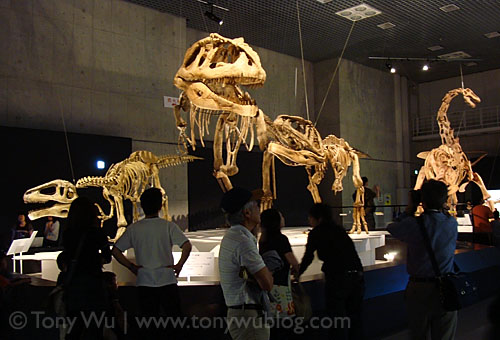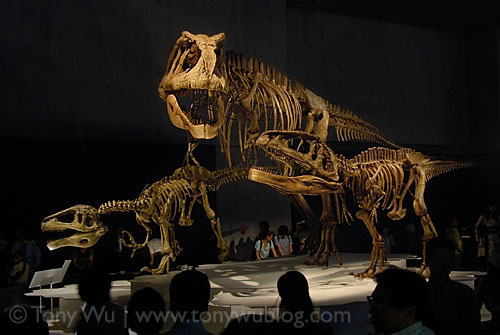It just occurred to me that the dinosaur exhibit I went to recently provides a convenient backdrop for making a photographic point...specifically, that if you want to take nice pictures, you should really learn how to control exposure manually.
For the sake of illustration, let's compare a couple of images. First, here's a photo of the trio of Mapusauruses on display (with a veggiesaurus of some sort in the background), taken with a Sony DSC-W300 compact digital camera set on P mode (automatic everything):

Acceptable, but nothing special, right?
Compare it with the photo below, which I took with the exact same DSC-W300, in the exact same building, with the exact same dinosaurs, with the exact same ambient light:

Much more dramatic, wouldn't you agree?
Besides shifting position to crop out and conceal some of the distracting bits in the background, I switched to Manual mode, then reduced the overall exposure level by about 1.7 stops.
The net effect? I eliminated a lot of the un-necessary visual clutter, like the grating on the ceiling, the detail in the background concrete, the detail in the people in the foreground, etc., making you see what I wanted you to see...a trio of menacing beasts towering over curious onlookers.
I was also lucky...gaining the unanticipated bonus of having strong light fall on the people on the far side of the podium leaning over to read something...perfect for showing scale.
In the first picture, the camera did exactly what it was supposed to do...adjust settings to give as neutral an exposure as possible. That's the way cameras are programmed, so that's what you get if you let the camera decide everything.
In the second picture, I basically executed a manual over-ride, and told the camera that I wanted to create an image that's darker than an average exposure...in order to hide the unsightly bits and bobs, while accentuating the cool stuff with hooked claws and sharp teeth (how's that for technical-speak?).
The take-away message is that if your camera has manual controls, learn to use them. I'm not talking just about expensive DSLRs. The camera I used for the photos here is a compact that I carried in my pocket (I was too lazy to lug a bigger camera across town).
When your pictures don't turn out the way you want (underwater or on land), it's tempting to blame your camera...but keep in mind that quite often, just fiddling with a few settings will make a big difference.